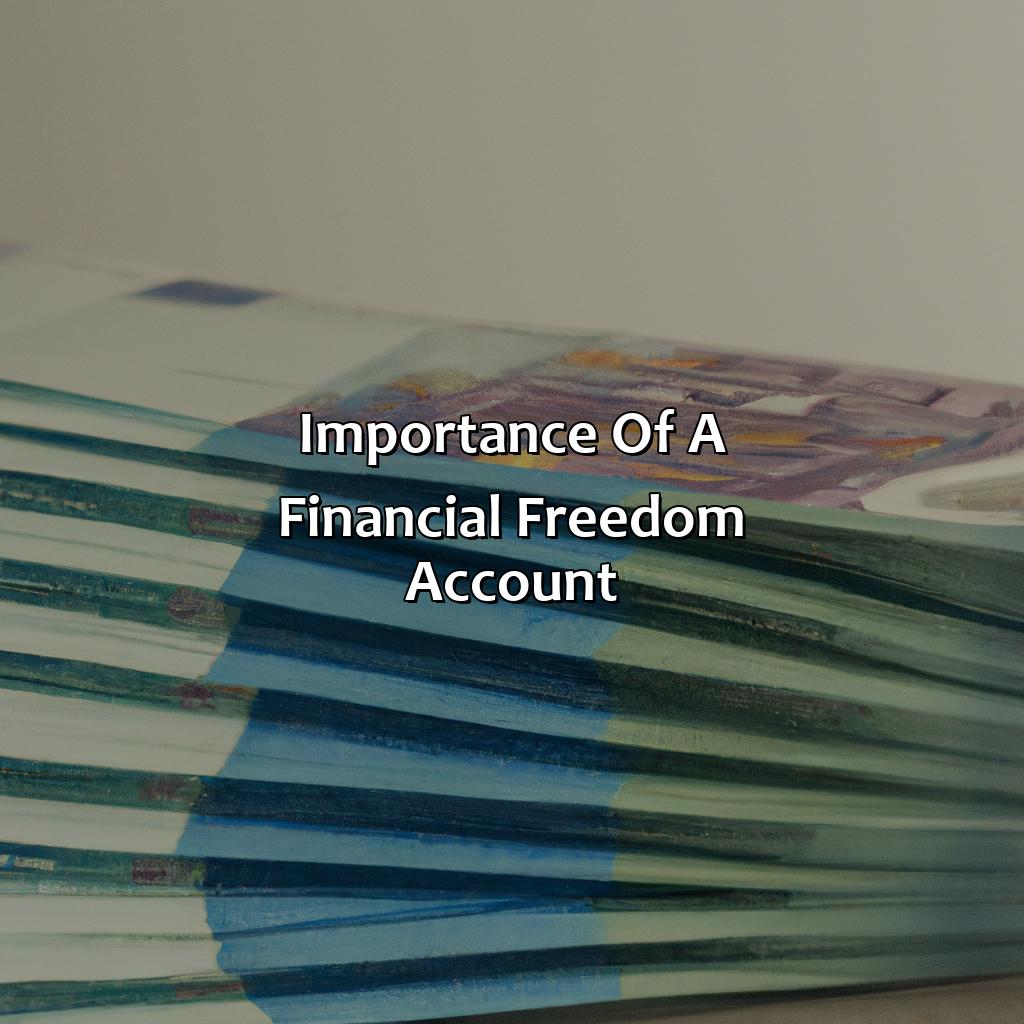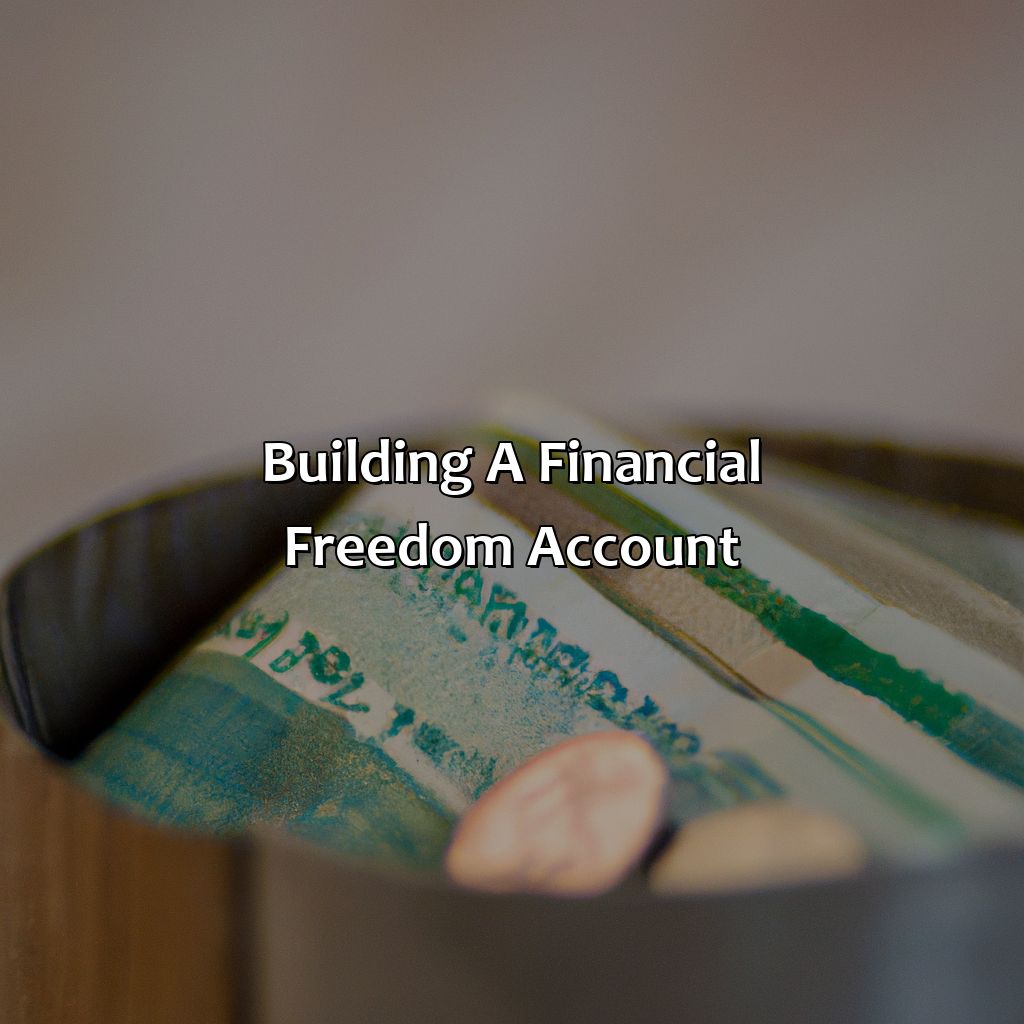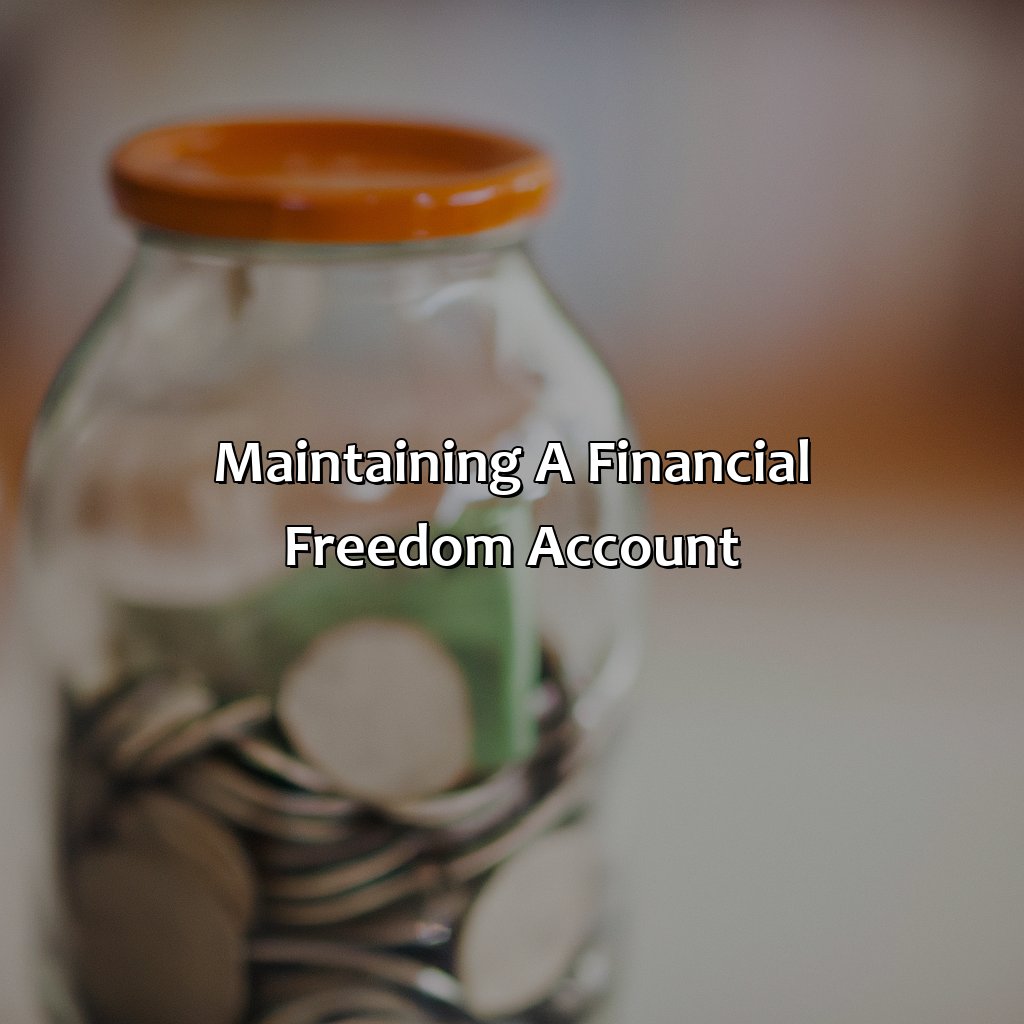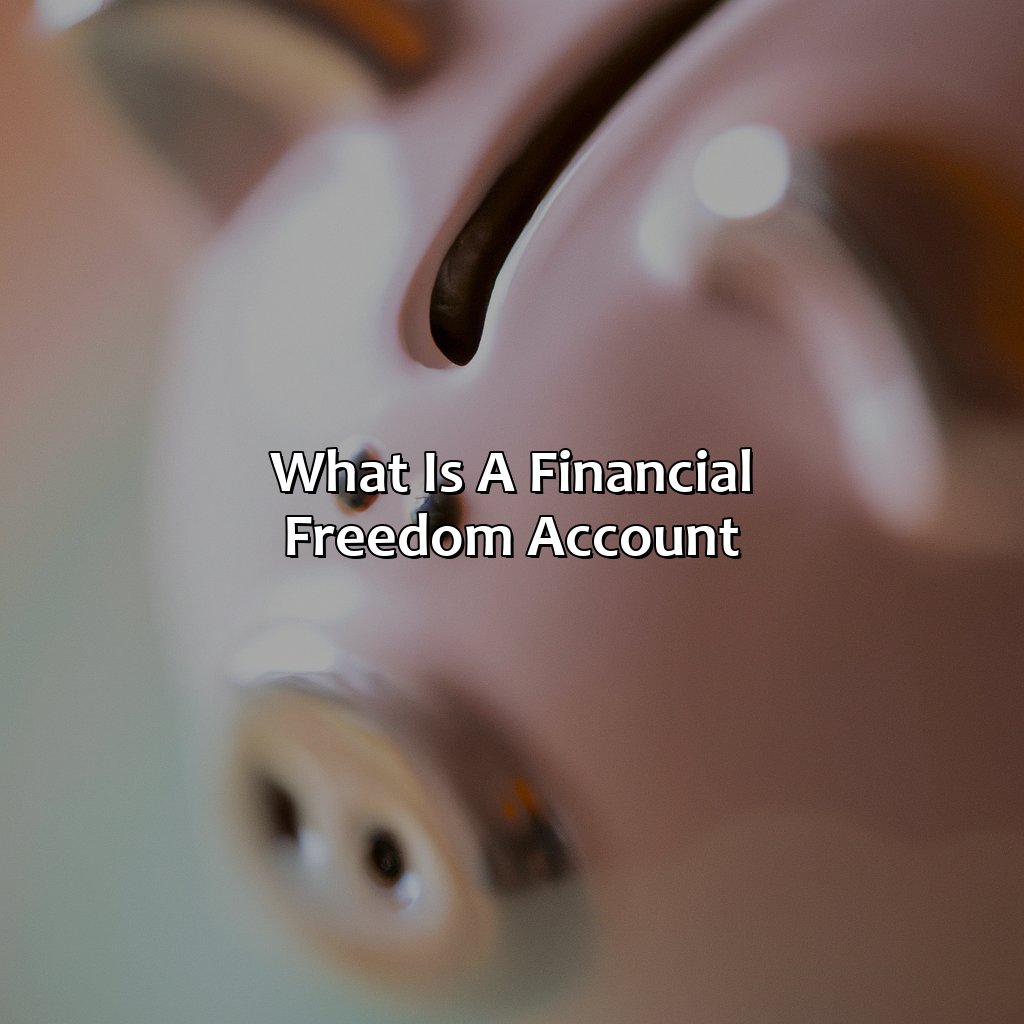What Is A Financial Freedom Account?
Key Takeaway:
- Financial Freedom Account (FFA) is a separate savings account used to set aside a certain percentage of income for long-term financial goals, which helps secure financial stability and create a safety net for unexpected expenses.
- Building a Financial Freedom Account requires determining necessary expenses, setting financial goals, and creating a budget plan. Continuously maintaining the FFA involves implementing automatic savings, keeping track of expenses, and reviewing and adjusting the plan as necessary.
- Having a Financial Freedom Account provides peace of mind and helps achieve financial independence, which translates to being able to live a fulfilling life with fewer financial worries.
Are you looking for ways to take charge of your financial future? Learn about the advantages of a financial freedom account and how it can help you achieve financial freedom. You can take the first step in taking control of your finances and secure your future today.
Definition of a Financial Freedom Account
A Financial Freedom Account (FFA) is an emergency fund that enables you to avoid debt in times of hardship. Developing an FFA helps you achieve financial independence. A well-prepared FFA should cover three to six months of living expenses. An FFA requires financial discipline and should be kept in a separate savings account with easy access.
Having a Financial Freedom Account is vitally important as financial difficulties do arise, such as a medical emergency, loss of a job, or unforeseen repairs. This fund offers you the financial freedom to weather such situations without compromising your life goals or forcing you to incur debt. It gives a sense of financial security and peace of mind.
An FFA is different from a traditional savings account, where savings would be used for planned events such as vacations or down payments on homes or cars. An FFA sets aside savings for life’s unexpected events, thereby preventing a financial challenge from becoming a financial crisis.
Creating an FFA will help you take control over your financial journey. Start now and begin by planning to put aside a small amount regularly. It will be worth it in the long run and will provide the peace of mind, knowing that you have the financial freedom to deal with life’s ups and downs.

Image credits: retiregenz.com by Yuval Arnold
Importance of a Financial Freedom Account
A financial freedom account is essential for financial security. Let’s explore why. It secures your financial stability and builds a safety net. Having this account is key to achieving ultimate financial security. Let’s look into how it helps to protect your finances and create a secure safety net.

Image credits: retiregenz.com by Yuval Arnold
Securing Financial Stability
Ensuring a stable financial future requires considering various factors, including having a substantial and dependable source of income, managing expenses diligently and efficiently. However, undoubtedly a Financial Freedom Account is one of the most efficient methods to achieve financial stability. This account provides an individual with the freedom to cater to unforeseeable financial emergencies without creating any hindrance in their daily expenses.
A Financial Freedom Account is an account that a person creates exclusively for unforeseeable financial requirements such as loss of jobs, unplanned medical expenses, etc. One of the distinctive features that make this account essential is its distinctiveness from other savings accounts and emergency funds, which majorly serve endless purposes. The freedom it offers empowers an individual to stay calm even when faced with unexpected events.
What sets this fund apart from others are two unique attributes: it should not be used for recurrent bills or long-term goals. Rather than relying on credit cards or loans, this type of account allows people to have complete autonomy over their future without incurring any debt. This serves as a lifeline during difficult times.
Karen had been saving money aside by using her Financial Freedom Account since she started working at 24 years old. When she lost her job suddenly during the pandemic’s onset, Karen was able to pay for her family’s day-to-day expenses until receiving unemployment benefits plus she immediately invested time into finding job prospects instead of worrying about how she would pay her bills back home.
When life throws you lemons, make sure you have a financial safety net to catch them.
Creating a Safety Net
Having a financial buffer is essential in times of unexpected emergencies and economic hardships. One effective way to create this safety cushion is by establishing a Financial Freedom Account (FFA). This account can help you set aside funds to cover unanticipated events, such as loss of income or medical emergencies.
An FFA can give you peace of mind while also enabling you to live life on your terms. Such funds can be saved proactively towards experiences such as vacation, retirement, or taking time off work without jeopardizing your long-term financial health.
The creation of an FFA should not hinder from other crucial savings goals such as retirement or paying off debt but can instead be used for contingencies. It’s ideal to aim towards saving at least three months worth of living expenses. Setting aside small amounts consistently will ultimately build the amount required in the longer run.
One example where an FFA could have been useful was seen during the COVID-19 pandemic outbreak when unemployment rates increased, and people’s incomes took a hit. Those who had created an emergency fund were better equipped and less stressed about their finances.
By having funds available for the unexpected events that arise, it allows one to remain independent and support yourself through times of hardship, without increasing debt or derailing your other financial goals.
Your Financial Freedom Account is like a secret stash of cash, except the only person you’re keeping it a secret from is yourself.
Building a Financial Freedom Account
Your financial independence starts with you. Figure out your must-haves. Set goals. Create a budget.
These steps will help you make the most of your money. You’ll save more. You’ll be on the path to financial freedom.

Image credits: retiregenz.com by Joel Washington
Determining Necessary Expenses
To determine the essential expenses, it is crucial to analyze and evaluate your regular expenditures. Categorize your fixed and variable costs like rent/mortgage payments, bills, transportation, groceries, health care and etc. Analyze if you can reduce some expenses or eliminate unnecessary costs to save money.
It is also important to keep track of your spending habits for a particular period like a month or two. This will give you an idea of where your money is going, how much you spend on each category and where you may cut back on expenses.
Create a budget based on your earnings, necessary expenses, and savings goals. Add up all the required expenses to calculate the minimum amount needed each month.
Pro Tip: Always adjust your budget accordingly as needs change over time. Reviewing the necessary expenditure regularly helps in monitoring finances effectively ensuring that everything remains within planned limits.
Setting financial goals is like planning a road trip without a map – you’re likely to get lost and end up at a sketchy gas station in the middle of nowhere.
Setting Financial Goals
Mapping out aspirations for money management
If one wants to shape their financial success and stand independently, it is essential to establish Financial Objectives. This strategy will encourage a sense of direction and deliver clarity on how much capital you want to obtain.
To excel in achieving Financial Goals, mapping a structured plan with step by step progress can elevate chances of execution. Identifying key milestones and tasks can be set up to achieve the ultimate goals. Successful implementation of these tactics amplifies performance.
Executing proposed passages like these is not that simple. There are credit card bills, monthly rent, EMIs and the list goes on hindering your path towards success- this exercise identifies where we should focus our attention to handle difficulties better.
It has been found in studies conducted by the Harvard Business Review that those who created clear benchmarks had more confidence in dealing with future cash changes instead of those without a clear aim or approach.
True Fact: Having an objective doubles the chances of executing the task (‘Harvard Business Review’).
Don’t let your money fly away like a flock of seagulls – create a budget plan to keep it grounded.
Creating a Budget Plan
A Financial Plan Strategy
To create a financial plan strategy, a budget plan is an essential component. It is crucial to understand how much money is coming in and going out, and also prioritize expenses and savings goals.
Four-Step Guide:
- Understand Income: Determine your monthly income from all sources.
- Identify Expenses: List all your monthly expenses; distinguish the fixed and variable ones.
- Create a Budget: Prepare a balance sheet of income vs expenses, categorize them into necessary or luxury.
- Track Results: Keep track of your budgeting results, make adjustments if necessary.
One crucial aspect to consider when creating any budget plan is room for flexibility and emergency funding.
It’s daunting, but sometimes waiting out until payday can seem too lengthy without external support. A real-life example involves an individual who used savings from their emergency fund after experiencing car repairs that they did not anticipate during the month.
Keeping a financial freedom account is like feeding a Tamagotchi, except the only thing that dies if you forget is your dreams.
Maintaining a Financial Freedom Account
Automate your savings to maintain a financial freedom account. Track expenses for control. Review and adjust your plan regularly to hit financial goals. This is the solution!

Image credits: retiregenz.com by Yuval Washington
Automatic Savings
Understanding the Concept of Money-allocation:
Creating a “Fund Management System” is crucial for a successful financial plan. Automated savings where funds are directly transferred to their destination, instead of solely relying on self-discipline, forms an integral part of it.
Three-Step Guide to Automated Fund Saving:
- Begin by calculating your monthly expenses and financial goals.
- Select an automated saving plan or app that suits your needs.
- Create a separate bank account exclusively for your Savings fund.
Understanding the Nuances:
Automated savings allow you to contribute to your Financial Freedom Account without feeling too much burden on your present lifestyle. These contributions can quickly stack over time, thus helping in sizeable investments.
Call-to-Action with Fear of Missing Out:
It’s not too late! Create your automatic savings plan today and start building towards financial independence. Do not let tomorrow be the day you regret not starting today! Act now, and secure a prosperous future.
Keeping track of expenses is like being a detective, except instead of solving crimes, you’re solving the mystery of where all your money goes.
Keeping Track of Expenses
Keeping a Record of Expenditures
To avoid overspending, it is essential to maintain a record of expenses. This will help you stay on track and allow you to handle your funds more responsibly.
- Make use of applications or tools that monitor your spending.
- Maintain a monthly budget plan to keep track of your funds.
- Save receipts for all expenditures you make.
- Keep a record of various expenses, such as food, transportation, utilities fees, etc.
It is crucial to keep track of all expenditures accurately to ensure that the budget scheme functions correctly. It would aid in saving money and lowering surplus expenditures.
Unique details on keeping records
Know where and how much money you are spending by selecting applications that fit your requirements. Make time each day to enter data about cash outflows and verify bank account statements regularly.
According to Moneycrashers.com, monitoring expenditures regularly can help prevent wasteful spending patterns.
(Source: https://www.moneycrashers.com/budgeting-money-management-tips/)
Adjusting your financial plan is like updating your Facebook status – if you don’t do it regularly, people might start to worry.
Reviewing and Adjusting the Plan
Regularly Revising and Tweaking the Financial Plan
It is crucial to regularly review and make necessary adjustments to your financial plan, taking into account various factors that may affect it. By doing so, you will be able to discover problems early on, preventing them from quickly spiraling out of control. If you do this, your financial freedom account can continue to grow.
During the review process, assess whether your current expenses align with your future goals and if you need to make any cuts or rebalance investments. In a dynamic financial landscape, where economic situations and personal choices change, it’s prudent always to be updating our financial plans.
It is wise always to keep an eye out for better deals on credit cards or insurance policies – reviewing expenses monthly or quarterly might prove worthwhile in this regard. The consideration of promoting contributory balances or refinancing loans should also form part of a regular review.
You can consider adjusting the income-to-expense ratios in line with changing expenditures as one top suggestion and regularly trimming down recurring expenditure on items like cable packages or subscriptions by prioritizing needs over wants. According to studies, such costs often add up without adding much value to lives making them luxury items we cannot afford; streamlining accounts can help free up resources allowing extra savings as another beneficial step.
Some Facts About Financial Freedom Account:
A financial freedom account is a separate savings account dedicated to achieving financial freedom. (Source: The Balance)
The account is used for long-term savings and investments. (Source: Investopedia)
The goal of the account is to reach a point where passive income exceeds living expenses. (Source: The College Investor)
Financial freedom accounts can consist of stocks, bonds, mutual funds, or real estate investments. (Source: Dave Ramsey)
Contributing a percentage of income to a financial freedom account is a key step in achieving financial independence. (Source: Forbes)
FAQs about What Is A Financial Freedom Account?
What is a financial freedom account?
A financial freedom account is a separate savings account set up specifically for the purpose of achieving financial independence. It is designed to cover expenses that allow one to maintain a desired lifestyle without having to rely on traditional employment income.
Why should I have a financial freedom account?
A financial freedom account is an essential tool for achieving long-term financial independence. By setting aside a portion of your income specifically for the purpose of covering expenses that allow you to maintain your desired lifestyle, you can create a safety net that lasts until you are financially independent.
How do I start a financial freedom account?
Starting a financial freedom account is easy. All you need to do is open a separate savings account and designate it as your financial freedom account. Then, automate contributions from your paycheck or checking account to ensure that you are putting money aside on a regular basis.
What type of expenses can I use my financial freedom account for?
Your financial freedom account can be used for any expenses that allow you to maintain your desired lifestyle. This may include things like rent or mortgage payments, utility bills, transportation costs, groceries, and other regular expenses.
How much money should I contribute to my financial freedom account?
The amount you contribute to your financial freedom account will depend on your income and expenses. A general rule of thumb is to set aside between 10% and 20% of your income each month. However, you may need to adjust this amount based on your individual circumstances.
Can I use my financial freedom account for emergencies?
While your financial freedom account is primarily designed for covering expenses that allow you to maintain your desired lifestyle, you can also use it for emergencies. In fact, having a well-funded financial freedom account can be an essential part of your overall emergency fund.
 Checkout this IRS Loophole
Checkout this IRS Loophole 
